I've written little in recent months, but one recurring theme has been the experience of seeing places through new eyes. It's become a defining characteristic of the second half of the year, and it's perhaps no longer surprising to me to find myself challenged or intrigued by places I thought I knew. But the last week or so has been a little different - experiencing London, and specifically some segments of it I really don't know well at all, completely afresh. Exploring in tandem with someone who has never experienced the maelstrom of the city before, and who has probably been exposed to - and equally cynically rejected - most of the storybook pre-conceptions that I arrived with all those years back. This was a strangely fitting way to end the year.
The first new horizon broached was Camberwell. Until now for me, a conspicuous gap in the atlas. It has no railway station anymore - despite once being a desirable village suburb on the southern fringe of the city. In the intense, hot whirl of the summer the BBC ran an episode of "The Secret History of Our Streets" which covered the rise and fall of the area, and the durability of some pockets of leafy perfection. At the time this seemed like an interesting but anodyne programme - why did I care about this southern suburb which wasn't even worth a stop on the train? But arriving at the junction of Camberwell Church Street and Denmark Hill, we found the intensely busy hub which is repeated all over London. The locus of thousands of lives - which really is their London, and bears little relation to the gilded gates and ancient towers north of the river. Buses edged around the traffic, the Sophocles Bakery leaked enticing fumes, the pubs belched merry punters onto the after-work streetcorners. In the midst of this, the Church Street Hotel. A strangely latin influenced hipster boutique. A strong vein of Catholic iconography, lots of bold colour and crazy tiling. A beautifully detained interior behind a suitably anonymous, toned-down grey frontage. This was our home for a couple of nights - and a base to make some early forays into the city. First impressions are of course important - but where places are concerned they are malleable. Few cities more so than London, which throws surprises in at each turn of a corner. Starting as we meant to continue, the first night was a whirl of activity. A bus to Waterloo, and dinner under a railway arch. A walk along the river, Parliament lit yellow and looking deceptively benign across the water. Then another bus along The Strand and through the City. St. Pauls gleaming above the Thames, the Bank, the towers of Bishopsgate. Then south over London Bridge and through The Borough to return to Camberwell. It was dizzying - perhaps over-ambitious for a first trip into London. But it was an arc through the layers of history which is something I've always tried to convey in words and likely failed. Tired and bewildered, Camberwell felt strangely homely on our return. The little knot of streets still busy with traffic and pedestrians, little open now except the supermarkets and convenience stores. We stop into a pub, where there is surprisingly good music being played and a pleasant babble of conversation. Despite the incredibly cosmopolitan nature of the district, the clientele is surprisingly uniform.
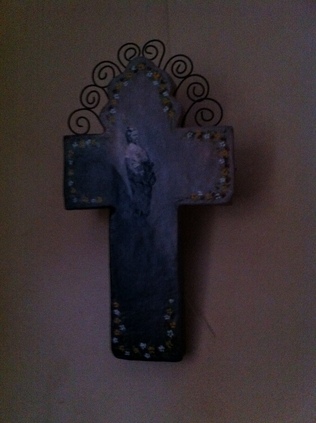
Regular readers will know that the West End is a closed book to me, as is much of Westminster and the more traditionally tourist side of London. This isn't wilful obscurantism - I'm really not fond of crowds, and my first visit to London during a cold December many years ago included being swept along Oxford Street in horribly dense eddys of humanity. I've avoided the place since - I've rarely the urge or the means to shop, and there has always been something more interesting elsewhere. Aside from the area immediately surrounding Victoria station, the environs of Buckingham Palace are equally obscure to me - but it was here that we ended up. After a superb and lazily drawn-out breakfast at a tiny cafe near Victoria, we skirted the back wall of the Palace - the drab, spike-topped cordon which would appear entirely un-royal if not for the frequent plaques warning of its special legal status, posted in suitably discreet white on grey and in a less-than-officious font of course. This approach has the advantage of concealing the grandeur until the very last second, the great facade suddenly appearing to our left, St. James' Park and the public space around the Victoria Memorial opening before us. As ever, a crowd of tourists milled and photographed. We did the same, and I confess I enjoyed it. It might have been the company of course - and certainly the novelty - but seeing this at the end of a year when royalty has been ever-present was odd and surprising. It hasn't felt particularly real to most of us I'm sure, and the dreadful TV coverage of the Jubilee did nothing but distance the Royals from the viewing population. But here, in the middle of the whirl of the city is the iconic balcony - smaller and lower, strangely close to the people milling about. Guards march back and forth, cameras flicker for the shot. We walk along Constitution Hill - our original plans changed by jetlag and time constraints. Another bus ride later I'm in more familiar territory around Marylebone, a stroll up Baker Street marvelling at the line for the Sherlock Holmes museum even at this late stage of the tourist day. Sick, dizzy and tired - it was time to head home.
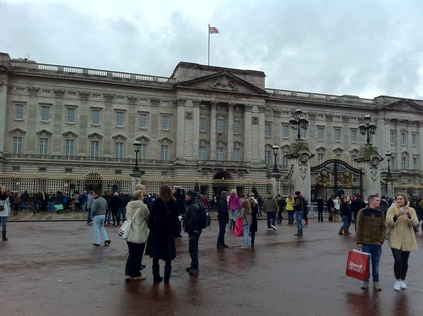
But this wasn't the end of the London experience... Travelling on the last day of the year, we returned to more familiar ground for me, descending on Bishopsgate in the early evening. If the first part of the visit had been a confusing, sometimes disconcerting whirl - I wanted this at least to reflect a little of the London which I experienced. A city where one can step back from the tumult and see the accretions of time. We wasted little time into getting out into the evening - the city was shifting into party mode, the stores closing early and the crowds beginning to appear on the street. New year in London is an event, a public spectacle of fireworks and drunkenness. We skirted this and turned east, heading for The English Restaurant in Brushfield Street. Oysters and robust, excellent fare in the dark, wood-panelled dining room was a fitting way to spend the evening. It was possibly the best meal I've ever eaten, and it was distinctly of the city. The dark but warm interior of the building discharging atmosphere, the solid Englishness of the dishes completely in context with the surroundings. In true London style, we were served by a range of non-natives - Australian barmen (naturally) and a genuinely pleasant northern waitress who was enthusiastic about the food. We wandered in the chaos of the late evening happily fed and watered. This was a new experience for me - this part of the city is about desperate, high-speed runs, about snatched moments in busy days. So to be here with accommodation on the brink of the east was a luxury. We plunged into Spitalfields, navigating around the glowering hulk of Christ Church and sliding into the darkness of Fournier Street. This part of the city seems so familiar, but it's new to see it in the dark of a winter evening. The buildings glow with an inner warmth. Generations of ghosts cluster at the windows, clamouring for a look at the gaudy, neon swirl of Brick Lane. We emerge into the maelstrom. The curry houses are doing fine trade - but still the patrons send their staff out to press-gang more trade from the streets. The New Year has been adopted by the locals here, and Indian girls totter by on impossible heels while another of their number tries to loudly encourage a drunken colleague back onto her feet. She hasn't quite made it to the new year - slumped against an old brick wall which has propped up the dissipated for many, many years. We turn a corner and regard a significant spot - the sundial on the Jamme Masjid. It's odd to be here now, tonight - completing a circuit begun years ago when I first took the picture of this curious device and it's sonorous motto. Then continued when I sent the picture flying across the world last summer - a significance which only now begins to reveal its magnitude. We stand a while, and yes - it's an emotional moment - one which closes the dizzy, unbelievable swirl of 2012 in an appropriately reflective tone.
We want to get back in time for the bells and fireworks, and take a crazy dash through the detritus of Petticoat Lane market and the commercial edgelands which divide the City from the East End here. It's been a whirl of new experiences these past few days - endless dashes from train to bus and back, time spent renewing my acquaintance with the city through entirely new eyes. I appreciate again what an enormous, unmanageable churn the city is. I remember how early on I learned to break it into chunks - the villages of London, so well illustrated by our entry point at Camberwell. Real life, of course, is always different - but to be reminded that this is practically on my doorstep is never a bad thing.
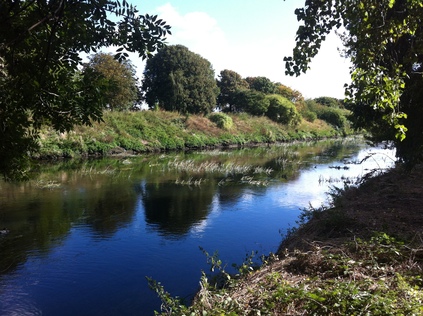
Not Afraid of the Dark: The Old River Lea
Posted in London on Saturday 29th September 2012 at 10:09pm
There is a fairly certain sense to my London wanderings, built around a particular set of trains and a surprisingly uniform pattern of travel. I haven't, in the main, set out to do this consciously - more it's a mixture of necessity, comfort and the repeated urge to walk certain paths. In part this has been down to a sense of impending change to the structure of the area or the looming denial of access necessitated by the Olympics. However, today was different on many footings. Firstly, I was arriving from Marylebone having spent the previous evening at the London Palladium seeing bands. This in itself was a strange take on London, with me having to negotiate the less than loved West End. Secondly I was very conscious that my mind was elsewhere today - an ocean away in fact - and that my focus was dominated in a far from unwelcome way by influences elsewhere. Oddly though, this dazed and planless situation led me to familiar territory - and after a winding and surprisingly warm sun-drenched journey atop a No. 30 to Hackney Wick, I found myself touching down on Eastway - resuming the lost threads of earlier walks which seemed to unravel in the incomplete traffic interchange.
This meant initially managing the mess of pedestrian facilities at the end of Ruckholt Road once again. I dashed across, uneasily eying a pile of memorial flowers in the circumstances, before discovering that the route I'd picked my way along before was stopped up - a barrier pointlessly cable-tied across the path with no obvious purpose. I had to turn back and make an increasingly fraught set of dashes across roads of uncertain priority. The last one took me uncomfortably close to the decaying flowers, but suddenly and unexpectedly I came upon the continuation of Homerton Road, and beside it the slope down to the course of the Old River Lea. The history of the river in this area is complex - with channels being opened and dammed, made navigable then abandoned. But this ancient course persists despite falling on hard times more than once in the last millennium - a sluggish, curling, snake-like presence which defines the eastern edge of the vast and dizzying space of Hackney Marsh for much of its length. Once on the official path I quickly realised that the river was hugged by an unofficial path which ran close to its western bank. This well-worn trail was almost silent, occasionally frequented by dog-walkers roaming off plan, or by fishermen - but usually oddly silent beyond a screen of trees which eventually became a thick tangle of woodland. I set off, dodging the odd encampment of blue bags and burnt logs which indicated recent, if provisional, occupation. It was quiet and cool at the waters edge and I found my way to a quiet spot near a stopped-off bridge bearing the ODA's "Changes" notice which now looked forlorn, damaged and inconsequential. However, the changes it wrought were still real enough, as at the end of the bridge was East Marsh. Now the Eton Manor Transport Hub - a temporary facility now being inelegantly removed and restored against all good advice. Still this process confounds and destroys, even after the last javelin has been thrown.

I wait at the bridge, take pictures and with a desperation and enthusiasm which catches my still bleary-eyed self off-guard, read the latest transatlantic tract. Cheered beyond reason, I move on - the river cast in a new light as a channel of hopeful emerald, swinging to the west and skirting common land - Lammas Land no less. Ancient and open by statute, but today occupied by a loud, howling tannoy as part of the Countryside Live event. I can't imagine any speck of wildlife for miles around tolerating the keening noise of feedback and banal chatter, and I follow the path towards the confluence with the Lee Navigation which completes the circuit for me. At the junction, a grassy path leads away under the range of electricity pylons which dominate the scene, towards the familiar exposed innards of the abandoned power station - a brooding presence. I stop for wide-angle skyline shots to indulge my obsession with the changing and shifting London boundary here. To the south, the Arcelor Mittal Orbit and the upturned skeleton of the Olympic Statdium, to the west is Canary Wharf, the sinister pyramid atop One Canada Square dominant, and to the north, the ruins of the power station. Between them, the barcode facade of the flats on the Lesney Site and the inelegant high-rise planning gain of Stratford City. But separating them from me, a sea of marshland and bent municipal football goals. The sea image is strong, distance acutely observed. It's time to move on...
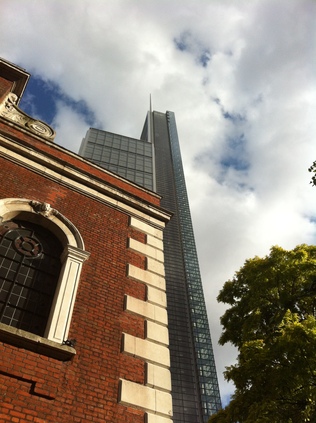
You can see more pictures from the walk here. As an experiment, you can also follow the route on the map below - the blue line is the walking route.
View Old River Lea Walk in a larger map
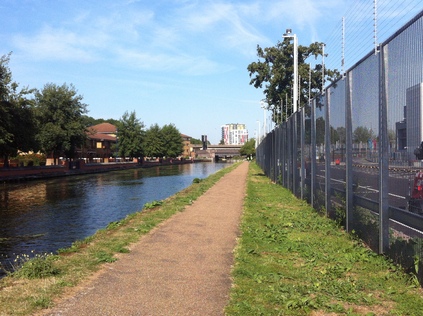
The Circle Completed - The Lower Lea Valley
Posted in London on Saturday 15th September 2012 at 11:09pm
The difference today was that I had at least planned to be here. My year planner is peppered with these trips to London in the safe knowledge that they will find me exploring some new geographical obsession or other, and that I'll have a reasonably relaxing journey on the rails. Sometimes, they become little excursions beyond the city - but even then there is always the luxury of an early arrival and perhaps a bus ride. With the world of railtouring changing considerably there have been more trips than I ever quite planned, but this has lead to walks across the eastern side of the city I'd probably not have countenanced before too. In this sense at least, the fractured and haunted summer has been a success in retrospect and I look back fondly on those walks which sometimes didn't seem significant on the day, but which have clicked into place later. I could only hope today would do the same for me. Because, today I had half a plan.
Today was, essentially, a completion. I'd read online that the towpath along the Hackney Cut was open - if still patrolled by G4S around the Olympic Park perimeter. But it was open nonetheless, so after a lazy breakfast in welcome late summer sunshine I set off east on my usual bus route. It was quiet, a cool but shining morning as we headed around the arc of the bus route. I saw it through almost to its end, hopping off near Bow Garage for the walk to the Church. I stocked up on water too, it looked like later when the sun was high it was going to be hot. I dodged traffic at Bow Interchange and found the footbridge down to the towpath just how I'd seen it on that excursion months back. I pondered what that had started: campaigns, obsessions, imaginary love affairs, endless wanders. I descended slowly, savouring this progression onto what had become hallowed ground. A battle fought over a strip of scraggy land beside a turgid canal, walkers and cyclists uneasily united. It was good to be back. Quickly, The Fence is alongside. Beyond it? Nothing. No movement. The occasional distant crash or scrape as unseen contractors strip back "the overlay" from the park. Empty staff buses circuit, the contract outliving their usefulness. Occasional security cars emerge. Overhead, a helicopter constantly drones. Crossing and recrossing the park. Even now it's a focus for paranoia and concern. I walk on, past the Northern Outfall Sewer carrying the still off-limits Greenway, past Hertford Union Junction, White Post Lane. I'm on the stretch which was guarded when a small orange boat called "Vigilance" passes by. They're not interested anymore. I stop, take a picture, watch the sun bounce of the gilt lettering of Formans, speculators on the Olympic dream. I could oppose Lance Forman's take on the Games, but he's still here in the Wick, his modern but organic new headquarters swooping gracefully and cheekily nodding at the Orbit across the water. Finally I reach the closure point - further than I ever managed on this side. The little brick circle still allows cyclists to pause and read maps. The boat ties off here, the lime green shirted guards head into the park. I make a decision - I'll press on out of its gravity - I'll get free of this place at last...

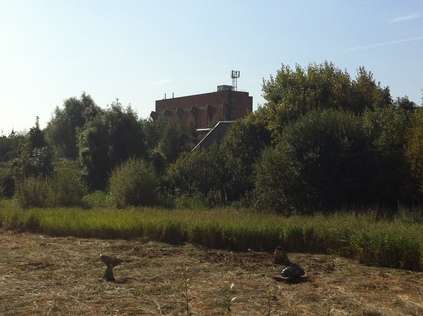
The last stretch is hard going - but is oddly rewarding. Busy boat houses provide a home for the canoes and rowing vessels which have passed me all morning, receiving commands from bicycling captains with loud-hailers. There has been a post-Olympic surge here, the junior section in particular is busy. Whatever the skepticism I might hold about the Games and this swathe of London, it's genuinely heartening to see this. On the east bank Springfield Marina is full of a different kind of vessel - a life on narrowboats always seemed a corny cop-out, but now I see it's attractions more clearly. Is this another mid-life crisis looming? I pause to finally empty my aching bladder at Markfield Park Cafe, in the shadow of the great Beam Engine. This one dealt in the pumping of sewage - part of the scheme which cleansed London of its filth, now regenerated into a rather fine little corner of the parkland with a museum, a cafe and places to relax and play. It felt positive and well-used. I considered lunch here, but again thought that stopping might be final. I returned to the path for the last push. Under the railway again, the curve to South Tottenham breaking off just feet from the river and the Cambridge line passing directly overhead. The river turns north and the Gospel Oak to Barking line crosses on a low bridge. Some young black guys explode from a side gate swaggering and yelling. I glance at one and with little interest he utters "Yeah. Come on then? What you gonna do then?". It's momentarily startling, but empty. He rails against everyone I guess, but fat white middle-class guys tramping river banks must be appalling to him. I press on, waiting for another walker to pass me before checking they headed in the opposite direction. Its the one time I've been even mildly concerned for my safety on the riverbank I realise. Finally, Tottenham Lock hoves into view - but just before it does, the path rises over a side-stream. Curving away in a concrete culvert is Pymmes Brook. It's an inauspicious little rivulet. Dirty and slow-moving in it's stony gully. But this leads onwards towards Tottenham where the tiny trickle of the Moselle River joins it. I have linked up with an earlier walk and it's strangely triumphant to think how there is coherence to my ramblings. I ascend to civilisation with some regret...there is more river to walk ahead, but not today.
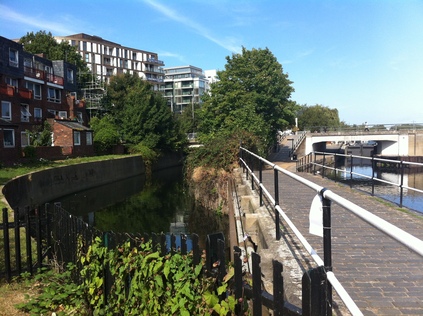
I realise I'm hungry and thirsty, and raid the newly opened Tesco near the station. Its a strange corner of public-private land here with fine new flats, a gym and a supermarket all protected by an ugly 1980s security kiosk - unmanned of course. No alcohol allowed. I munch pastries and glug fruit juice, wondering if this is allowed. Finally, dusted off and replete, I head for a train back to Liverpool Street and welcome coffee. I also realise that I booked a much later train than usual home - so there's no hurry, and I decide to use the buses to cross and recross the territory I've walked. To get a different slant on the land I've carved through by river. Thus I find myself crossing Lea Bridge and looking down on the spot I regarded it from earlier before arriving at Walthamstow Bus Station. A drunk has stumbled into a slow moving bus, an ambulance in attendance. Ill-governed crowds crush and flock to buses. I make the back seat of a 69 to Canning Town, wedged up against a tiny but pretty Polish mother. This bus takes me via Leyton, the eastern edge of the Olympic Park pushed up against the homes and shops of the borough. It's another circle complete - and another set of possibilities and gateways opened. What started with uncertain rail journeys before the bid, turned into a curious regard for this strange strip of land, and now manifests itself as an urge to walk, has come full-circle. This is now a voyage into post-Olympic London. Legacy delivered or reneged on? I find myself already wanting to be back here.
You can see more pictures from the walk here. As an experiment, you can also follow the route on the map below - the blue line is the walking route.
View Lower Lea Valley Reconnected in a larger map
Once again I found myself in London today, again without a firm plan, though not quite as unexpectedly as last week's jaunt. This habit of dashing to the capital runs counter to my original plan - that I'd not even try to visit the city during the Olympics or Paralympics. Having allowed myself a brief wander between the two, I was pretty surprised by just how little effect the games had on me last week, despite an unplanned lurch towards the park before heading off on my canal walk. And it was that walk which provided the kernel of the idea for today. Many years ago, for some lost reason, I found myself walking the towpath of the Regents Canal between Regent's Park and Camden Town. I don't remember quite why or how - but the odd serenity of the walk, and the strange noises emanating from London Zoo's aviary stick in my mind. Then again, years later I found myself stumbling around Colebrooke Row chasing the ghosts of the Lambs and wanting to get to City Road basin, just because it was a curious feature on the map which intruded into my then current territorial obsessions.
Skipping forward to today, I alighted from a bus at Angel Station. The sun was already high in the sky and beating torturously upon London. I got water and sustenance and headed for Colebrooke Row once again, taking the steep curving path which skirts the mouth of Islington Tunnel. On my way down I noted a gent idly pissing against the tunnel end wall while a couple of Japanese tourists sat nearby. It was going to be an odd walk. The plan was to link my travels - to go beyond City Road and to reach Victoria Park where I'd left the canal previously. From there? Who knows... These canal walks have become a little more than just explorations - they have become ways to re-evaluate territory I already know, and quick and easy ways of edging through the choked city above too. I set off eastwards, through the relatively affluent edge of Islington.

My first observation was how busy the towpath was here in leafy and largely well-off Islington - the canals of the east are deserted on the whole because of the inconvenient and illogical Olympic blockades and the message propagated by LOCOG and TfL that implies everywhere will be impossibly busy. Here though there was a constant traffic of joggers, families and cyclists. Notably they were less considerate than their eastern counterparts too - no bicycle bells rung in warning here, but should you not detect their presence they'd be rung in anger. Some of the overbridges create very tight walking spaces, but the cyclists push on through with little regard for pedestrians. Its a short walk to City Road and Wenlock Basins, where new territory starts in earnest. The banks here are edged with visiting boats which add colour and life to these sometimes eerily quiet zones too. The confused summer of damp weeks and days of intense heat has encouraged algae and there is a green carpet on the sluggish waters as I press on beyond Sturt's Lock and the canal begins a curve towards the south east. It's reckoned by official guides that this section of the route is the least pretty and interesting, but in truth aside from some notable developments which squeaked in before the downturn, its probably the least gentrified section of the canal. This makes for some splendid industrial vistas - tumbledown works, sometimes with their ground floors re-occupied by restaurants or art spaces. As the route turns around the north eastern edge of the city into De Beauvoir Town I'm struck by how many major routes cross it - the New North Road, the East London Line, the A10. The canal was the precursor of any future Ring Road.
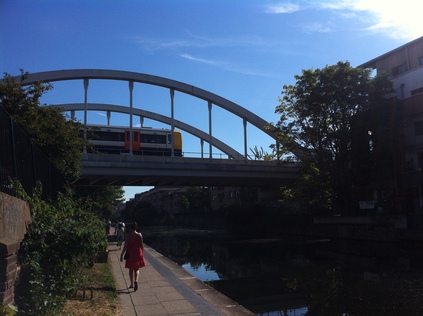
I rest awhile near Kingsland Basin, primarily a building site for a new development which against the odds is still underway. Families pass by shading babies against the intense heat. Joggers are reduced to walking pace, heads hung low, sweat drenched backs. They're an attractive bunch out here - and some of them have applied make up for their midday jogs. Perhaps this is how you meet people in the modern city? Pressing on into the backlands of Kingsland Road. The buildings crumble visibly, the canal is littered with junk. There are pop-up businesses here - vintage clothes, coffee, cakes - sold from boats which double as home. An alternative waters edge economy. Threading through South Hackney, the towpath again begins to get congested. The sweep around Andrews Road and the huge gasholders I'd snapped on an earlier walk is a particularly busy stretch - a film-crew idles in an abandoned and decrepit canalside house while Mare Street rages overhead. This is the last stretch now, as the canal draws alongside Victoria Park. It's leafier, cooler and the park draws away the bulk of the walkers here. The last stretch is home to some longer-term residents of the waterway. They sit at the back of their boats, discussing and reiterating, occasionally looking up to see who is passing. Finally, a little before Old Ford I turn into the park myself. I've found my way back to the spot which I reached on my Hertford Union trek a few weeks back. I reward myself with a rest. In the blazing sun of the park, London is doing the same. After negotiating an unwarranted and pointless police check I find a bench, make some calls, receive surprising a somewhat gloomy news. Instinctively, and perhaps ill-advisedly I strike out east across the park. Passing the unnerving Dogs of Alcibiades and cutting through the Night Walk to reach the quiet curve of houses, skirting Mabley Green and not really having any sense of where I mean to go next. A couple of students mess with expensive camera equipment in the long grass fringing the park - everywhere I go people are filming, trying to preserve this strange atmosphere. I come to my senses at the Eastway junction. I can see the route ahead which almost floored me a couple of weeks back. Any further, and I'd be straying too close to the source of my concerns. The last days of the Games are no place for me. I turn disconsolately back and head for the bus stop.
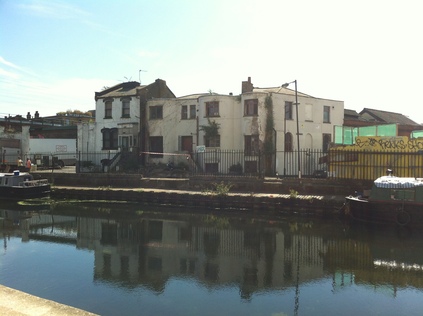
Whilst I hadn't meant to be here today, I was able to use the opportunity and the remarkable weather to cover ground I knew I would need to at some point. These last, heady days of the Olympic Summer have suddenly become significant, the country doesn't want to get back to normal - and the city has been lulled into a strangely calm sense of separateness. Tomorrow there will be speeches, fireworks, music - no doubt tears. On Monday, all being well some hi-vis wearing contractors will remove the barriers from the towpath on the Hackney Cut. That, after years of crossing and re-crossing the site, after failing to understand the nature of the site, was what brought me here. The summer of walking inland waterways - partly by design and partly by necessity is almost over too. There will be no ceremony - just new endeavours to understand the post-Olympic city.
You can see more pictures from the walk here. As an experiment, you can also follow the route on the map below - the blue line is the walking route.
View Regents Canal Revisted Walk in a larger map
Lost::MikeGTN
I've had a home on the web for more years than I care to remember, and a few kind souls persuade me it's worth persisting with keeping it updated. This current incarnation of the site is centred around the blog posts which began back in 1999 as 'the daylog' and continued through my travels and tribulations during the following years.
I don't get out and about nearly as much these days, but I do try to record significant events and trips for posterity. You may also have arrived here by following the trail to my former music blog Songs Heard On Fast Trains. That content is preserved here too.



